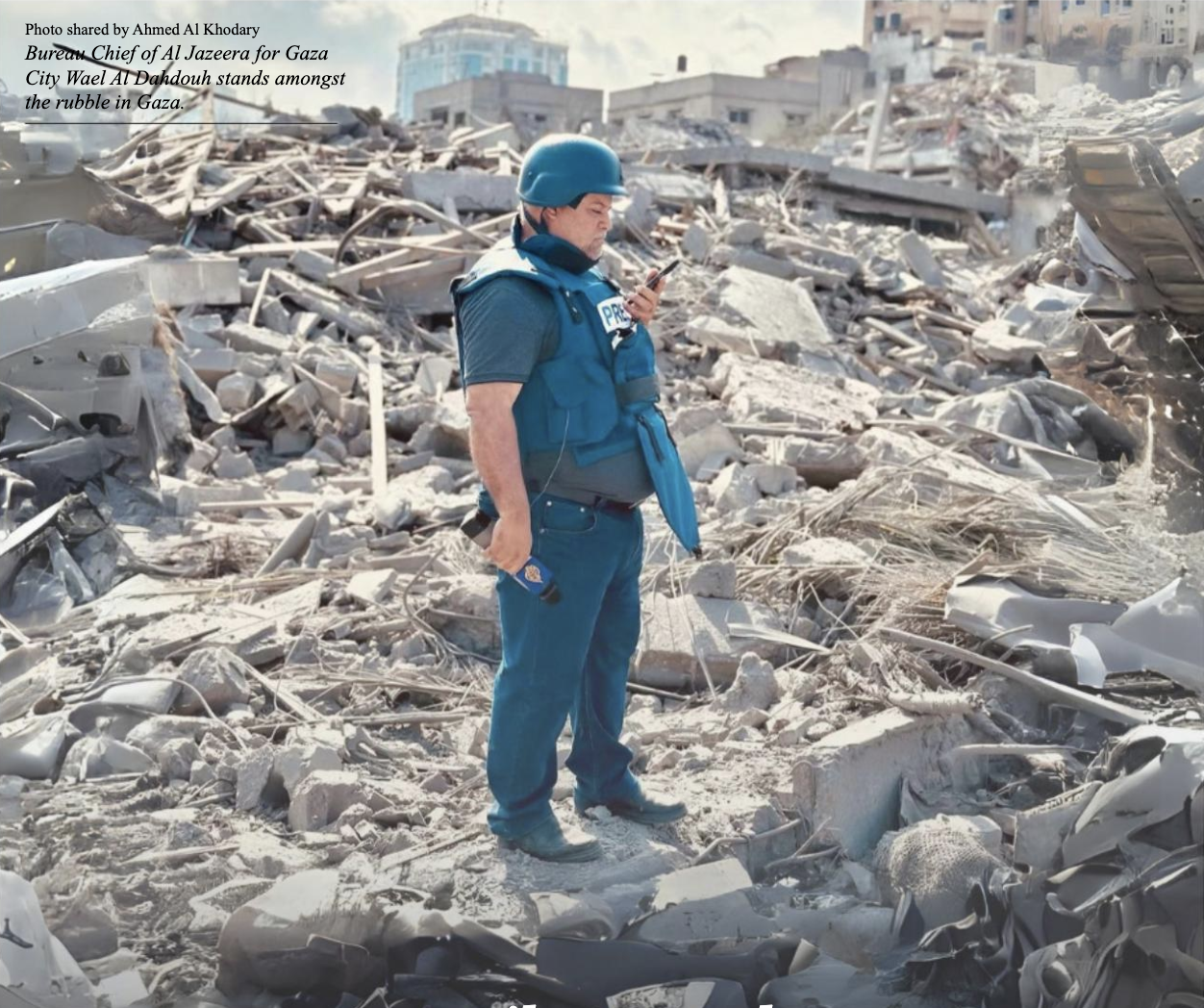
By: Noor Abdullah, Opinions Editor
As the humanitarian crisis in Gaza unfolds, leaving a majority of the population in desperate conditions, local journalists are right at the forefront, reporting on their experiences and that of those in Gaza. The daily airstrikes and other difficulties make simply surviving a struggle, yet they persevere and provide us glimpses into their world.
Homelessness affects nearly every Gazan as the United Nations shared that over 1.8 million Gazans, about 80% of the population, are internally displaced. Amongst the displaced is video journalist Bisan Owda, who now shelters in a tent in Southern Gaza after relocating seven times as designated “humanitarian zones” shrink. Owda sheds light on her new life onto her nearly 4 million Instagram followers. From walking 20 minutes to reach a bathroom to cramming around modified solar panels to access the electricity necessary to charge her equipment, she provides glimpses of the lengths she goes to document airstrikes and share information. She begins her statements saying “I’m still alive,” yet she remains hopeful, and encourages her followers to partake in spreading the news about Gaza, frequently calling for large-scale strikes and demonstrations.
Journalists have even been forced to flee Gaza entirely. 22-year-old Plestia Alaqad left in late November for Australia after sharing harrowing reports from the rubble of Gaza. She explained that she felt that she had a target on herself and her family due to her job. She shared, “I don’t feel safe, but especially when wearing the press vest and helmet”, presenting the threat that journalists in particular face in Gaza.
Al Jazeera Arabic Media Network correspondent Moamen Al Sharafi lost his parents and 20 other family members in an Israeli airstrike hit to the home they were sheltering in on December 6. Further, Al Jazeera’s Gaza bureau chief, Wael Al Dahouh lost his son, daughter, wife, and grandchild in an Israeli airstrike on their home in October, and another son and journalist for Al Jazeera, Hamza Al Dahdouh, in another Israeli airstrike that hit his car in early January.
The Israeli military claimed responsibility for the attack and spokesperson Daniel Hagari explained: “We understand they were using a drone. And using a drone in a war zone, it’s a problem. It looks like terrorists.” They were referring to freelance drone operator Mustafa Thuraya, who was in the targeted car with Hamza Al Dahdouh and also perished. Al Jazeera and other media networks have raised concerns regarding the misidentification of journalists as terrorists and their filming equipment as a threat.
This war has been dubbed the “deadliest war for journalists” due to the shockingly high casualty rates. The Gaza government’s media office claimed nearly 120 Palestinian journalists have been killed in Gaza since October 7, 2023, accounting for over one death per day.
Yet along with the unprecedented threats and losses this war has caused journalists, it has also revealed the strengths and limitations of social media. Social media platforms including X, Instagram, and TikTok have become common news sources, especially among younger generations and students at Mills.
Sala Alawdi (12) a senior at Mills with personal ties to the region aims to receive her information directly from the source: “I get most of my news on the war from Instagram and the account of Motaz Azaiza. He is press located in Gaza. His posts showing everything that happens cross the world in an instant.” Motaz Azaiza is a photographer who has become the face of social media reporting. His Instagram account has 18.2 million followers, his images of the destruction and death in Gaza are shared by media organizations and social media users alike, and one of his images was featured on TIME’s Top 10 Photos of 2023. Like all Gazans, Motaz has endured many difficulties in surviving and carrying on his job, sharing airstrikes in his neighborhood and his efforts to access the electricity and internet needed to share his pictures and videos. He also says that his images are sometimes flagged and taken down for “violating Instagram’s community guidelines”, with warnings of repeated violations leading to a suspension of his account, his main method of sharing his work.
Bisan Owda, Plestia Alaqad, and Motaz Azaiza share the common traits of being proficient in English, reporting mainly from social media accounts, and being young, making them relatable and easily accessible for students who are a part of their combined 26.9 million followers. These factors are just a part of what causes the younger generation to stray away from traditional television news channels and instead follow qualified individuals.
Alissa Angeles Vasquez (12) shared, “I believe [reporters in Gaza] are the only way to get accurate, unbiased news. I want to be informed and I don’t want my news to be watered down with Western opinions of those who haven’t experienced anything like what Palestinians are enduring on a daily basis.” When asked what it was about their reporting style that appealed to her, Vasquez explained, “They are not afraid to make others uncomfortable. Hundreds of people are dying daily. Media outlets are not classifying it for what it is, this is a genocide. [These journalists] show you the heartbreak of those who have lost their families, the lack of food and medical attention and such to move you to do something.”
As Israel has banned international journalists from independently entering Gaza, claiming it’s due to a lack of safety guarantee, reporting on live events is a dangerous task left to local journalists. They persevere through forced relocation, homelessness, untreated injuries, familial losses, suspicion, and censorship to provide vital on-the-ground coverage of a war in which misinformation is rampant.
As aspiring journalists and truth seekers, the Thunderbolt Staff extends appreciation and admiration to the brave journalists of Gaza.






